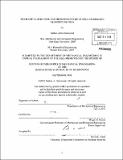Mechanical behavior and microstructure of self-assembling oligopeptide gels
Author(s)
Hammond, Nathan Allen
DownloadFull printable version (8.833Mb)
Other Contributors
Massachusetts Institute of Technology. Dept. of Mechanical Engineering.
Advisor
Roger D. Kamm.
Terms of use
Metadata
Show full item recordAbstract
Hydrogels have become widely used in the fields of tissue engineering and drug delivery. One class of hydrogel is formed from synthetic oligopeptides that self-assemble into a solution of beta-sheet filaments. These filaments can aggregate to form a gel suitable for culture of various cell types. Examples of such self-assembling peptides are RAD16-I, RAD16-II, and KLD-12. One limitation of self-assembling peptide hydrogels is their mechanical weakness. Herein are presented computational and experimental studies that elucidate the microstructure and mechanical behavior of these materials. Strategies to enhance their mechanical properties are also examined. Steered molecular dynamics modeling was used to characterize the mechanical interaction between filaments, and a coarse-grained model was developed to extend the system to ordinary time scales. A microindentation assay was developed and used to characterize the mechanical properties of gels. Several strategies for enhancing the gels' mechanical properties were tested. Gel microstructure was observed in thin sections of material with transmission electron microscopy, revealing in detail the loose, disorganized structure of assembled beta-sheet filaments. The results demonstrate that these self-assembling peptide gels are formed from a loosely arranged structure of beta-sheet filaments, not from dense bundles of parallel filaments as was previously proposed. Estimates of gel stiffness based on this loose structure are in approximate agreement with experimental measurements. Among the strategies tested to increase gel stiffness, introducing cross-links and increasing solid concentration proved to be effective approaches.
Description
Thesis (Ph. D.)--Massachusetts Institute of Technology, Dept. of Mechanical Engineering, 2010. Cataloged from PDF version of thesis. Includes bibliographical references (p. 97-103).
Date issued
2010Department
Massachusetts Institute of Technology. Department of Mechanical EngineeringPublisher
Massachusetts Institute of Technology
Keywords
Mechanical Engineering.